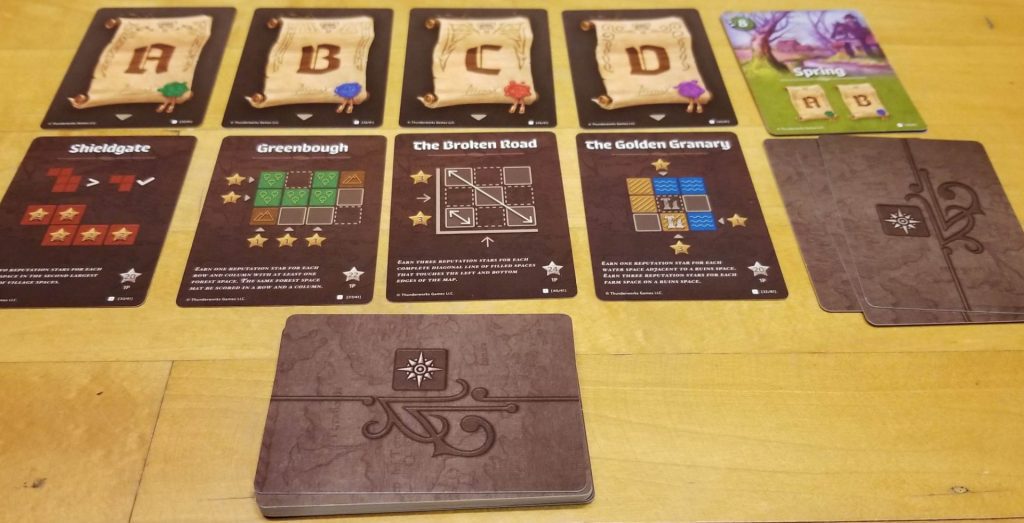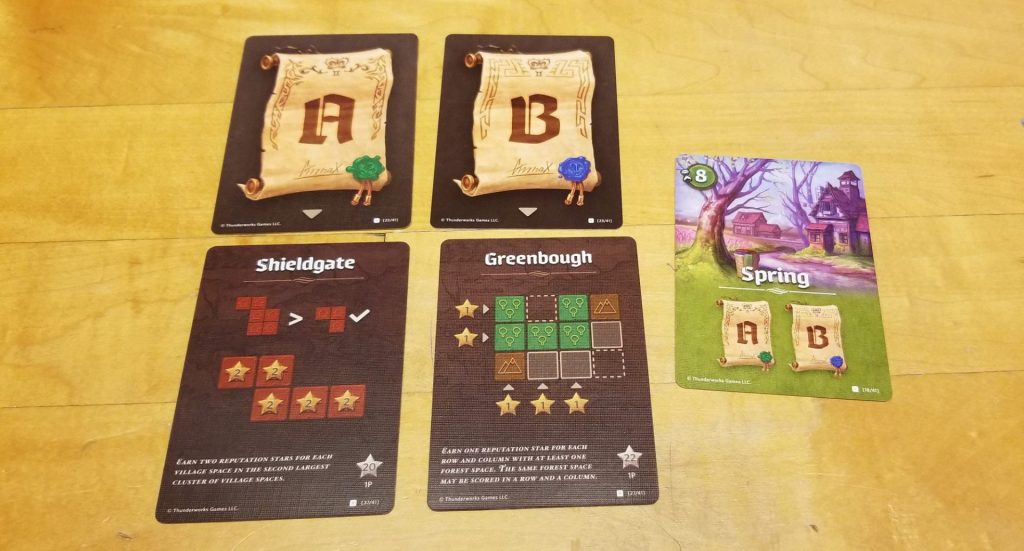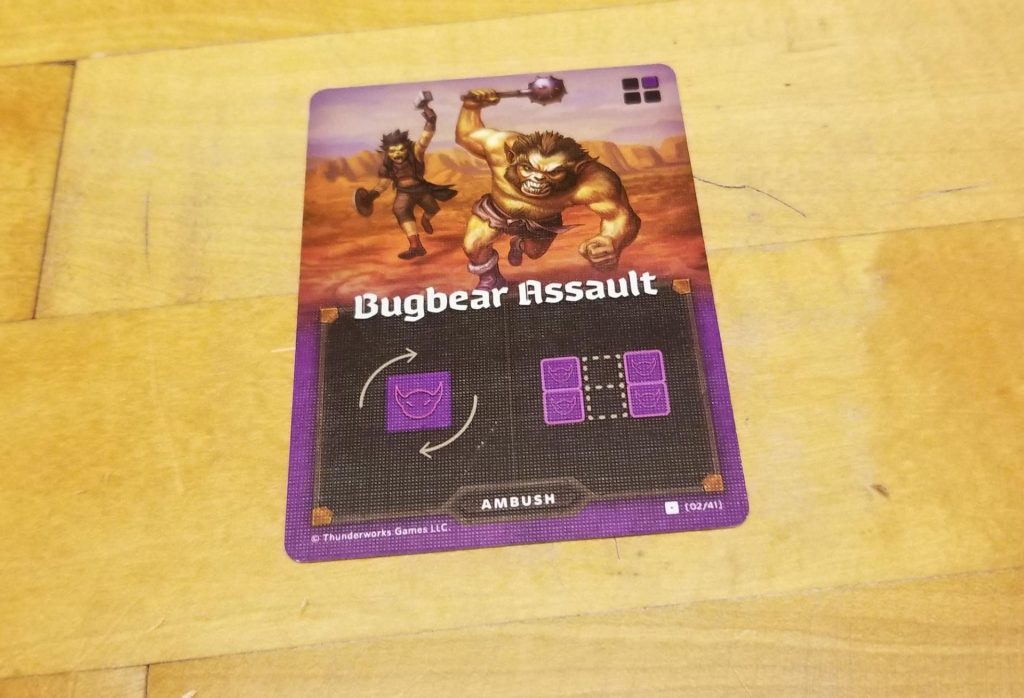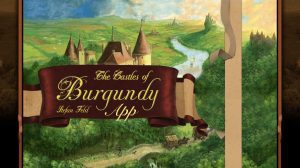The Kingdom of Nalos is awe-inspiringly massive; its reach seemingly endless. As expansive as it is, though, it used to be even larger. Many hundreds of years ago, the Dragul appeared and claimed the northern lands as their own. And now Queen Gimnax aims to take that land back.
The goal is to eventually establish a seat of power there, but Queen Gimnax is very particular about where that seat will be established. The surrounding lands should contain certain vital resources and should provide natural defenses. And now it’s up to you, one of her most trusted cartographers, to travel deep into the enemy stronghold and map out the region in the hopes of finding her exactly what she’s looking for. The voyage is fraught with peril, but the reward — should you succeed — will be quite substantial.
This is the setting for Cartographers, a flip and draw game from the mind of Jordy Adan and published by Thunderworks Games – the same company that brought us Roll Player. In fact, Cartographers is billed as “A Roll Player Tale” because it exists within that same universe.
In Cartographers, cards will be flipped over from a deck at the beginning of each turn. The flipped over cards represent the various landscape features that the nominal cartographers encounter on their expeditions. As these cards are flipped, the players will draw the features onto their maps in any way they wish, keeping in mind the variable scoring criteria that are laid out at the beginning of every game. When the game draws to a close at the end of four seasons, the person who has accumulated the highest score wins.
This is, of course, a very high-level overview of how Cartographers is played. If you’re not interested in the details, then feel free to skip ahead to the Thoughts section. For everyone else…
Picture Pages, Picture Pages
To begin a game of Cartographers, each player will be given a map sheet and a pencil. These sheets are double-sided and the players should agree which side they’ll play with. One side is meant for more advanced play and features a large chasm that significantly restricts the available space. The other side is much more open and is the best bet for beginners. The game play will remain the same regardless of which side you choose to use.

Once the players have their map sheets, it’s time to lay out the cards. First, the Letter cards are laid out in order. Then the scoring cards should be shuffled into four piles according to their card backs. One card will then be selected from each of these piles and randomly placed beneath each Letter card. Then the Season cards are placed into a face-up deck in ascending order (Spring on top, followed by Summer, Autumn, and Winter).

Next, the Ambush cards should be shuffled into a deck and placed aside to form a small draw pile. One of these is drawn from the top of the deck and shuffled in with all of the Explore cards. This deck is then placed face down and you are now ready to begin playing Cartographers.
There Is a Season (Turn, Turn, Turn)
Cartographers is divided into 4 different seasons and each one will score for different criteria. For instance, Spring will score for whichever cards are beneath A and B while Summer will score for whichever cards are beneath B and C. This scoring system is very similar in nature to Isle of Skye, so if you’ve ever played that game you’ll grasp this concept immediately.

Each Season card has a different number printed in the top left corner of the card. This is a sort of time counter that dictates when the season will come to an end. This number corresponds to the numbers printed on the Explore cards. During each season Explore cards will be flipped up one at a time and, in addition to dictating which shapes and features may be drawn that turn, these cards will also use up time as well. For instance, Spring has a time counter of 8. If you turn up an Explore card that has a 2 printed on it then you have used up 2 of your 8 total time. If you ever reach or exceed that number with a card flip, that season comes to an end once everyone draws in their features on their maps. Players will score at the end of each season based on that season’s scoring conditions before moving on to the next one.
Pencil Me In
When an Explore card is revealed it’s going to display two distinct items – the feature(s) that will be drawn in and the possible shapes that feature can take on the map. If there are multiple features shown the players choose which one they wish to draw. Some players may decide to draw one feature while other players decide to draw the other – and that’s perfectly fine. That’s one of the nifty things about playing this game: your final map is going to look nothing like anybody else’s.

And when it comes to drawing in the features, you also have a choice between either of the shapes shown (if multiple shapes are shown). If one of the shapes has a gold coin next to it and you decide to draw in that shape then you’re going to get to color in one of the coins on your map sheet (we’ll get to this momentarily). The shape drawn may be flipped, turned, and spun around however you choose. If you’re able to fit it into your map somehow, then you must. But if you can’t, no sweat. You’ll get to draw a single square anywhere that you’d like and fill in that shape with one of the features shown. While this might seem like a bad thing, sometimes it can be a blessing in disguise. More importantly, it’s worth noting that you will never have a wasted turn in Cartographers. You will always have something to do even if it isn’t incredibly beneficial.
Gimme Some Money

Cartographers provides a lot of opportunities to score points; one of the most lucrative being the accumulation of coin. In addition to obtaining coin from Explore cards, there is one additional method. If you are able to surround one of the pre-drawn mountains on all of its cardinal sides (north, south, east, west), then you’ll get to fill in a coin on your map sheet. These coins will score you points at the end of each season and they’re cumulative. So each time you’re gaining a coin, you’re setting yourself up to gain even more points in future seasons.
They Did the Monster Mash
Everything you’ve done in Cartographers has led up to this… every line drawn, every tree penciled in, it’s all going according to plan. Then an Ambush card gets flipped up and it all falls apart. This “Ah ha!” moment makes you realize what makes Cartographers so special.

When an Ambush card gets flipped up, you’re going to have to pass your map sheet to one of your neighbors and then they will have the opportunity to draw in the assigned monster feature on your sheet. Ideally they’ll try and use the monsters to fill in any empty spaces on your map sheet in order to help you score points. Ideally. But that isn’t what’s going to happen. They’re going to find the most inconvenient spot and plop the monster down right there and it’s going to cause you no end of consternation. Still, don’t be too upset. Eventually the map sheets are going to be passed in the other direction and you’ll have the opportunity to return the favor. And this brings us to the scoring.
It All Comes Down to This
Now that the season has ended, it’s time to calculate your score. At the bottom of the map sheet there are four different scorings shown, each one divided into four sections.

In the first box will be the total derived from the first scoring criteria. In case you forget just which one you’re supposed to be scoring, the box has been helpfully labeled to assist you. The second box is for the second scoring criteria and the third box is for the total amount of coins you have colored in thus far. The fourth box requires a little more explanation, though. That’s for monster scoring.
Any space around any drawn in monsters that isn’t filled in with something is going to cost the player 1 point. Left unchecked, this can add up to a substantial amount. Consider this example:

Once the players have completed and scored for Winter, then they’ll add up their scores from each season and the person with the highest final score is the winner.
Thoughts
I could preface this section with a lot of exposition, but not today. I’ll just get this right out there: I love Cartographers. From the components to the aesthetics to the game play, this game is pretty much perfect. Since I have very few negative things to say, let’s just delve into what makes Cartographers such a great game.
It begins with the aesthetics. Before you’ve even cracked open the box, you’re already met with Lucas Ribeiro’s amazing illustration. The pensive look on the main character’s face closely resembles the one you’ll be wearing as you scratch your chin trying to figure out the best place to draw in whichever shape fate has decreed you’re stuck with. The campfire burning not too far away and the snow collected here and there really sucks you into the scene and you can already imagine the chill in the air. You can almost envision the puff of breath that would accompany the little goblin’s speech as he points out a specific feature of the map laid out before him. And this kind of thing carries into the game itself once you’ve started laying it out on the table. Each illustration has a vibrancy and life of its own and it really helps to sell the story. Even the graphic design on the map sheets is slick and attractive.
And those map sheets… wow. The paper these things are printed on has some real heft to it. Thunderworks Games could have gone a cheap, flimsy paper route but they have chosen to go the route of quality and to very good effect, too. Every portion of this game feels great in your hands. The cards are thick and durable and have a nice linen finish to them as does the box itself. Even the rule book is nice and compact. The only issue that I had with any of the components were with the pencils that were included. The erasers aren’t the greatest quality and smudge things into oblivion more so than making them just go away. Also, during my second game as I was furiously erasing a feature that I didn’t like the placement of, the eraser portion of my pencil broke off. I don’t mean the eraser fell out. I mean the metal holding the eraser in place physically sheared off. I’m not complaining too much here, though. Thunderworks Games didn’t HAVE to provide me with pencils and I’m grateful for the fact that there are some included in the box, but you’re going to want to invest in some higher quality pencils if you plan to play the game very often.

Then there’s the game play.
One of the most fascinating aspects of Cartographers is the method in which randomness is introduced into the game. With very few exceptions like Imperial Settlers: Roll and Write where the dice are rolled and each player shares the results, most roll and write games have each player rolling the dice on their turn and then doing something with those results (Ganz Schön Clever and On Tour, for example) before passing the dice on to the other players. Not Cartographers, though. Much like the game Welcome To… Cartographers uses a deck of cards to dictate the action and every player does their thing at the same time. While roll and writes are a dime a dozen these days, flip and draw games are much less prevalent. I suspect that is going to change, though, if Cartographers and Welcome To… are any indicators.
Another aspect of Cartographers that really speaks to me is the variable scoring conditions (which is one of the things that draws me to Isle of Skye). With 4 different scoring criteria decks and 4 cards per deck, that’s over 6,000 possible scoring criteria combinations that you might encounter! Knowing that each round is going to be scoring based on certain conditions creates a very interesting decision space. Do I just focus on doing the very best that I can in this round and hope that this kind of focus works out in the end or do I split my focus between what’s important now and what will be important in the future since I know which scoring criteria are going to be scoring at the end of which seasons?
And then you have the sneaky player interaction that gets introduced by way of the Ambush cards. While many roll and writes feature some sort of indirect player interaction (having to choose from the leftover dice in Ganz Schön Clever, for instance) very few feature the level of player interactivity that you’re likely to encounter in Cartographers (although you might not!). Just when you think you’ve got it all figured out, a monster appears and you’ve suddenly got this thing sitting in the middle of your map sheet threatening to eat away at your point total. Should you ignore it and stay focused on your game plan or do you scrap whatever you’re doing and try to cauterize the wound? Or maybe a hybrid approach would be best. There’s no right answer. All you can do is hope that you’ve made the right decision and that everything will work out in the end. Whichever way you choose to go Cartographers manages to find the right balance between skillful play and pressing your luck to keep everything fun. Also, seeing the things your opponents have drawn on your map sheet is really amusing.

The only thing about Cartographers that really didn’t speak to me was the backstory. I took a few liberties when I presented the story at the beginning of this piece because the story in the book really doesn’t make a lot of sense. Here’s the actual text so you can judge for yourself:
“Queen Gimnax has ordered the reclamation of the northern lands. As a cartographer in her service, you are sent to map this territory, claiming it for the Kingdom of Nalos. Through official edicts, the queen announces which lands she prizes most, and you will increase your reputation by meeting her demands. But you are not alone in this wilderness. The Dragul contest your claims with their outposts, so you must draw your lines carefully to reduce their influence. Reclaim the greatest share of the queen’s desired lands and you will be declared the greatest cartographer in the kingdom.”
It was a struggle for me to even begin writing this review because I was trying to grapple with how to present the story in a way that was comprehensible. Aside from the pencils (which have the weird side benefit of making everything in the box smell AMAZING), this is really my only complaint.
But that’s not a deal breaker by any means. Cartographers looks great, smells great, is super easy to teach and play, and the game play is phenomenal. When you couple all of that with the game’s ability to accomodate 100 players right out of the box (limited only by the number of included score sheets), you’ve got a game that’s sure to be a hit. If you only ever invest in one roll and write (I know, it’s not a “true” roll and write – but it fills that same niche), then I highly recommend this one. There’s a reason that Cartographers has risen to the tops of so many reviewer’s Top X Games of 2019 lists. Once you play it for yourself you’ll understand why.












Add Comment